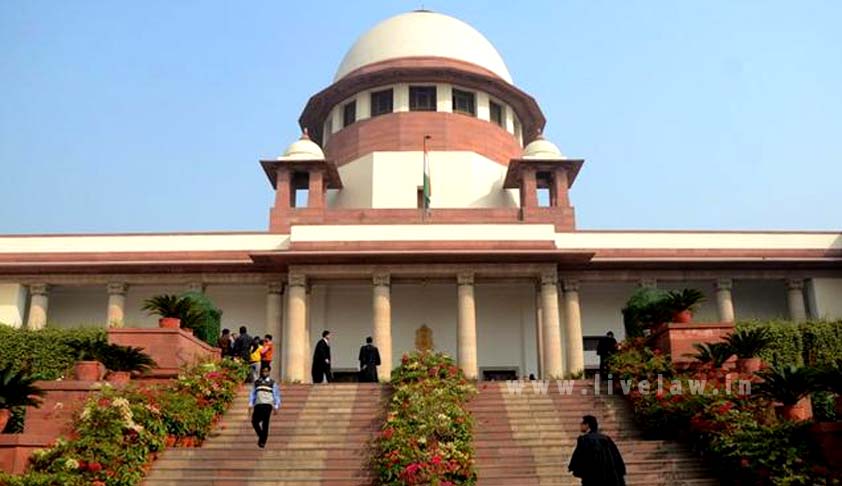- Home
- /
- Cover Story
- /
- Collegium - Government rift...
Collegium - Government rift widening, says report
LiveLaw Research Team
12 Jun 2016 6:43 AM
A news report published in The Times of India today says that the Supreme Court collegium has rejected all major proposals of the Government in drafting a new Memorandum of Procedure (MoP) to appoint Judges to the higher judiciary.The foremost of these proposals is that the criterion for selection of a Judge should be merit-cum-seniority. The collegium, on the contrary, appears to have told...
A news report published in The Times of India today says that the Supreme Court collegium has rejected all major proposals of the Government in drafting a new Memorandum of Procedure (MoP) to appoint Judges to the higher judiciary.
The foremost of these proposals is that the criterion for selection of a Judge should be merit-cum-seniority. The collegium, on the contrary, appears to have told the Government that it does not see any need for changing the existing criterion of seniority-cum-merit.
The dispute is not just about the phraseology of the criterion, as it may suggest. The collegium, it appears, believes that if the criterion, as is followed currently, is reversed as merit-cum-seniority, then Judges of high court, who are juniors in the all-India seniority list, may get elevated as Judges of the Supreme Court, and even chief justices of the high courts.
The collegium’s reluctance to accept the Government’s proposal makes little sense. The trend of elevating only the chief justices of high courts as Judges of the Supreme Court began to be followed only recently. This ‘informal criterion’, as scholar Abhinav Chandrachud calls it, has little merit, other than ensuring that the principle of seniority is respected.
No wonder, there is a race among the chief justices of high courts, for their elevation to the Supreme Court, the moment they are appointed as the chief justices of the high courts. As a result, it is said that the chief justices of high courts, knowing fully well that their days in the high courts are numbered, display little interest and enthusiasm in contributing to the administration of the high courts under their leadership.
It is because the chief justice of a high court retires at the age of 62, whereas a Judge of the Supreme Court retires at the age of 65. Besides, a retired Judge of the Supreme Court, has opportunities to be considered for the post of chairpersons of several tribunals, before or after retirement.
Gone are the days when a high court chief justice, like Justice MC Chagla, the then chief justice of the Bombay high court, could decline the offer of elevation to the Supreme Court, because in the high courts, a chief justice would be No.1, whereas in the Supreme Court, he or she would be one among the 30 Judges.
Bringing the retirement age of high court Judges on par with that of the Supreme Court Judges is one reform which cries for attention of Parliament.
The second would be not to confine the posts of chairpersons of commissions and tribunals to only those Judges who serve the Supreme Court.
A judge of the Supreme Court is no different from the judges of the high courts, in terms of their legal acumen and wealth of experience. Therefore, to discriminate between them, and favour the Judges of the Supreme Court, in terms of better statutory benefits, is doing injustice to the high court Judges, who fail to get elevated to the Supreme Court, not entirely due to their lack of merit.
The collegium is probably concerned about the lack of respect for the seniority principle in the Government’s new version of MoP because, once it is conceded, then the there is no stopping the Government from ignoring the seniority principle even while appointing the Chief Justice of India.
This imaginary concern is perhaps not valid, because as far as the CJI appointment is concerned, the principle of seniority has stood the test of the time, with the pre-Emergency days telling us how a partisan Central Government could play havoc with the independence of judiciary, by denying the post of CJI to the senior-most eligible Judge of the Supreme Court, simply because he had ruled against the Government in many cases.
The TOI report refers to the recent instance of the Government sending back for reconsideration a recommendation for appointment of a chief justice of a high court, resubmitted by the collegium after reconsidering once.
The Government’s contention appears to be that a reiterated recommendation need not be binding on it, if it is shown that it was not unanimous, or that the collegium did not furnish reasons for rejecting a dissenting view expressed by those Judges consulted by the collegium. This is a debatable proposition.
The report also refers two more disagreements between the collegium and the Government. One is that the collegium has rejected the Government’s suggestion of 10 per cent cap or a maximum of three senior advocates, who could be directly elevated from the bar to the bench.
The second is the Government’s insistence on a rule that the collegium ought to provide reasons for rejecting a candidate for appointment as a Judge. While the collegium feels that such a rule would mar the future prospects of such a candidate for being considered as a Judge, the Government finds that it would help to evaluate the claims of a candidate in any future appointment.
Basically, the current tug-of-war between the collegium and the Government over the MoP further reinforces the collegium’s reluctance to respect the principle of transparency in both letter and spirit.

